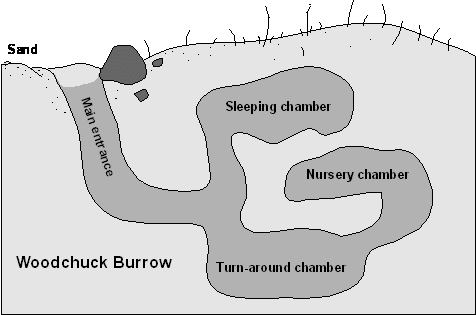Reading Comprehension (Performance Level: Advanced) – Question 01
Not Just a Hole in the Ground
by Elizabeth C. McCarron

1 The
woodchuck sits up on its hind legs, chewing a wild strawberry.
Looking around, the
chuck freezes when it spies the farmer’s
dog. The dog sniffs the air, spots the chuck, and charges
toward it.
The woodchuck watches the enemy coming closer and closer, then POOF!
The chuck
disappears from sight, and the dog is left puzzled. The
woodchuck has dropped into its burrow to
escape.
2 A woodchuck burrow is more than just a hole in the ground. It is a
complex system of
entrances, tunnels, and rooms called chambers.
Burrows give woodchucks a place to sleep, raise
young, and escape
enemies. When a woodchuck hibernates (sleeps through the winter), it
makes
a simple burrow and plugs the entrance with sand.
3 A woodchuck uses its strong claws to dig its own burrow. In soft soil,
a woodchuck can dig
an entire burrow in one day.
4 Each summer burrow usually has several entrances. This lets the woodchuck
roam and still
have a safe hole nearby in case danger comes along.
5 For the main entrance, a chuck may choose the woods at the edge of a
meadow. The hole
must be hidden from view but close to food.
6 The plunge hole is a special burrow entrance. It goes straight down two
or more feet. When
an enemy comes near, the woodchuck may give a
shrill whistle, then drop straight down into the
hole. This is how
the woodchuck “disappeared” from the dog’s sight!
7 Under the ground, tunnels and chambers connect the entrances. There is a
sleeping chamber,
a turn-around chamber, and a nursery chamber. A
woodchuck burrow can even have a bathroom!
A woodchuck may bury its
waste in a chamber. Sometimes it adds waste to the mound of sand
that
marks the main entrance. This mound lets other animals know whether
or not a burrow is
active (being used).
8 Many animals look for empty woodchuck burrows. And why not? The burrows
are warm in
winter, cool in summer, and ready-made. Rabbits use empty
burrows to avoid summer heat.
They may even pop into an active burrow
to escape an enemy. Skunks, weasels, and opossums
use empty burrows
as woodchucks do—for sleeping, hiding, and raising their young.
Foxes may
take over active burrows to raise their own young in the
warm dens.
9 Now you can see that a burrow is more than just a hole in the ground.
It’s the perfect place
for woodchucks—or other animals—to
sleep, hide, and raise young. To a woodchuck, there’s no
place
like its burrow!
Copyright © 2000 by Highlights for Children, Inc., Columbus, Ohio.
CSR1P326
A woodchuck finds a food source above the
outer part of its burrow.What is the woodchuck
MOST likely to do?
A dig another burrow
B take over another burrow
C hibernate for the winter
D dig another entrance
Results
- 27% of students gave this response.
- 11% of students gave this response.
- 20% of students gave this response.
- 41% of students gave this response. (Correct Response)
Note: Percentages may not total 100 due to rounding.


